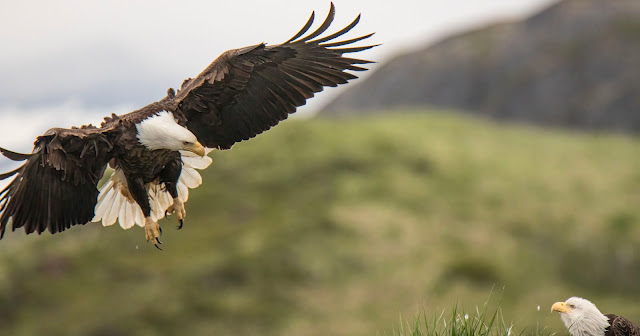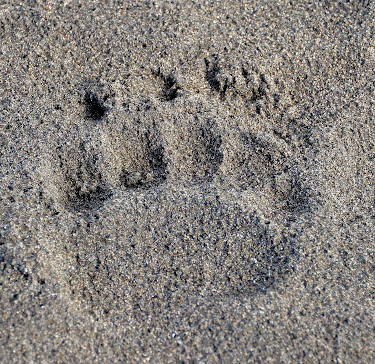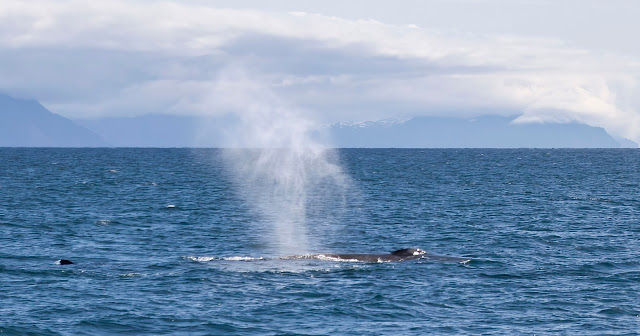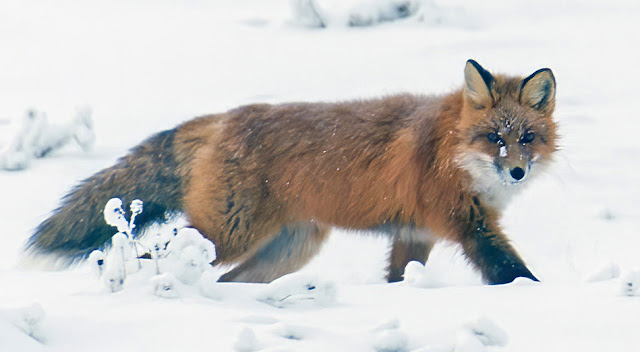 |
| Canadian Lynx; Photo: Scott Stevens |
Animals
If you are going to Alaska, chances are you want to see animals, like the Canadian Lynx above, and ...
If you are going to Alaska, chances are you want to see animals, like the Canadian Lynx above, and ...
 |
| Bald Eagles |
 |
Bears (these are Brown Bears) |
 | ||
Dall Sheep
|
 |
| Grouse (Spruce) and Ptarmigan (Willow) |
 | ||
Seals (these are Harbor Seals)
|
 |
| Mountain Goats |
 |
| Muskoxen |
 |
| Orcas |
 |
| Puffins (these are Horned Puffins) |
 |
| Porcupines |
 |
| Sea Otters |
If you are not interested in animals, why are you going?
Before you go to Alaska, familiarize yourself with the animals you might see. Let's start with Bears ...
Before you go to Alaska, familiarize yourself with the animals you might see. Let's start with Bears ...
Alaskan Bears
The Bear you'll have to work the hardest for – but will definitely recognize when you see it – is the Polar Bear.
Found only in the far northern reaches of the state (and rarely there, since they spend so much of their time on the sea ice), these huge beasts are the most dangerous because they seldom play games. No bluff charges or random growls. They are apex predators and wouldn't hesitate to kill and eat you. Just sayin'.
 |
| Range map: Alaska Department of Fish and Game |
I have already written about the species when I blogged about Svalbard, Norway, so I won't repeat myself. You can read about these magnificent animals here.
Just know that it is possible to see a Polar Bear in Alaska – not easy, but possible! Kaktovik is the best shot, but it is currently closed to visitors. Utqiaġvik is another possibility.
 |
| Nanook is the Inuit word for Polar Bear |
The two Bear species you are likely to see are Black Bears and Brown Bears.
 |
| Young bears: Black and Brown |
Some people struggle with telling them apart. So, here's a run-down of the differences between the two. First, let me clarify the names.
 |
| The coat has a silvery, grizzled appearance |
Black Bears, which are not always black, are pretty much always called Black Bears.
But, Brown Bears, which are not always brown, are called Brown or Grizzly Bears (and, on Kodiak Island, Kodiak Bears).
Dark-colored Brown Bears sometimes have silvery tips on their fur, especially on the back and shoulders, giving them a grizzled look. Hence, the name.
Generally, the term Brown is used for coast Bears in Alaska and Grizzly is used for interior Bears anywhere. Kodiak Bears were once considered separate from Brown Bears, but they are simply Brown Bears that live on Kodiak Island and, because of environment, tend to be bigger.
Since color is the most confusing aspect, let's start with color.
Black Bears can be black, blue-black, dark brown, brown, cinnamon, blonde and even white. In some areas, you'll find all or most of the colors in one population. Often, cubs are a different color than the mother and siblings can be different from each other.
In other areas, they all tend to be black, often with a light brown muzzle.
 |
| The lighter nose is pretty common on Black Bears |
Brown Bears, likewise, may range in color, from dark brown (but seldom true black) to blonde.
 |
| Brown Bears have a broad range of colors |
Many Brown Bears, especially darker ones, have a lighter collar or belt across their shoulders.
 |
| The Brown Bear's band can be quite pronounced |
Baby Brown Bears tend to be dark and have more prominent collars.
People often try to differentiate the Bear species by size. It is true that Brown Bears tend to be, on average, significantly larger than Black Bears, but size can be misleading. There are three reasons for this: Bears take some time to mature, so young Bears are smaller than older Bears; Male Bears tend to be much larger than female Bears; both species have significant size variations within them. So, a young female Brown Bear could easily be smaller than a mature male Black Bear and so forth.
There are also regional variations in size, so, for example, a Kodiak Brown Bear will probably be much larger than a Brown Bear in Yellowstone National Park.
 |
| A good-sized male Brown Bear |
The average weight for female Black Bears ranges from 90 to 375 lbs. and males range from 130 to 550 lbs. Female Brown Bears tend to weigh from 300 to 800 lbs. and males range from 400 to 1,200 lbs.
But, I have seen such variation that I would not trust these numbers. Basically, Brown Bears can weigh twice as much as Black Bears. In both species, males are about 30-50 percent larger than females. Most of the time.
 |
| Adult Brown Bears, female and male |
The largest known male Black Bear weighed more than 1,000 lbs. Coastal male Brown Bears can easily reach 1,500 lbs., but interior males generally top out a 500.
Also, when Bears emerge from the dens, they weigh about half of what they weighed when they went in.
Some of the weights I gave may be surprisingly low. People tend to overestimate a Bear's size, primarily because of thick fur and build (and, if it's approaching you, well ....).
Black Bears are about three feet at the shoulder when on all fours and can reach seven feet when standing; Brown Bears can be up to five feet at the shoulder and up to nine feet when standing.
To compare (just for fun), an adult male Polar Bear can weigh up to 1,600 lbs. and stand ten feet tall.
Another indicator of species is that Brown Bears have a very prominent shoulder hump because of the massive muscles they have for digging.
 |
| The Iconic Brown Bear hump |
When on all fours, the hump is the highest part of the Brown Bear and the rump is the highest part of the Black Bear.
 |
| Black Bears have a more rounded back |
But, while Black Bears don't tend to have a pronounced hump, some do have large shoulder muscles and a hump when standing in certain positions. In other words, the hump isn't always definitive.
Nose, ears and claws are better indicators.
Brown Bears have a more concave or "dished" facial profile, meaning that their snouts curve in and then out. But, Black bears consistently have a "Roman-nose" profile, meaning that the nose curves out and down.
 |
| A different profile: Brown and Black |
The Brown Bears's muzzle is broader and more prominent and the eyes appear closer together and deeper set.
 |
| The eyes have it: Brown and Black |
Black Bears have, generally, shorter fur. Brown Bears appear to have longer, fuzzier fur, especially on the face. But, once again, this is not across the board.
Black Bears' ears are, relatively, larger and slightly more pointed than Brown Bears, which have small, very rounded and furry ears, exactly like you would see on a stuffed Teddy Bear.
 |
| The difference in ears and fur between the Black, left, and the Brown |
And, although all these things can be confusing and hard to discern, there is no question about claws. Brown Bear claws are twice as long as Black Bears' and tend to be lighter, more gently curved (often looking almost straight), thinner and more spike-like.
 |
| Claws: Black Bear, left, and Brown Bear |
Brown Bears' claws are adapted for digging roots and excavating a winter den. Black Bears' claws are well adapted for climbing trees and tearing into rotten logs in search of insects. The problem is that you sometimes can't see the claws (or don't want to)
And, it you don't see the Bear, the tracks are also different.
 |
| Brown Bear track |
Characteristics such as diet, behavior and habitat are not reliable differentiators because Black and Brown Bears eat similar food, display similar behaviors and have some overlapping territories.
 |
| Both species love flowers |
Black Bears have much larger distribution than Brown Bears in the lower 48, but Brown Bears range farther in Alaska. Because Black Bears have smaller territories, there are significantly more Black than Brown Bears in the state: 100,000 compared to 35,000. Alaska has about 17 percent of North America's Black Bears and 70 percent of the continent's Brown Bears.
 |
| Range maps: Alaska Department of Fish and Game |
Even though Black Bears are more plentiful that Brown Bears, I have seen far more Brown Bears in Alaska, Once again, there are several reasons: first, we go looking for Brown Bears more often; second, Black Bears are a bit more timid; and, third, Brown Bears spend more time in open areas rather than in forests and trees.
Now, I always heard that Black Bears climb trees and Brown Bears don't. Not true ...
 |
Both species do (that's a young Brown Bear on the right) |
Generally, only female and young Brown Bears climb trees and you are still more likely to see a Black Bear in a tree.
 |
| Polar Bears don't even know what a tree is! |
I have seen mainly Brown Bears in mid and upper Alaska; Black and Brown Bears in the south, and Polar Bears in the far north. Bears are dangerous and Brown Bears are particularly so. Polar Bears even more so. Follow all the rules for the area you are visiting and you’ll be fine.
The best places to see Brown Bears? Katmai National Park during a Salmon run, coastal Lake Clark National Park or Denali National Park. There are many Bear viewing lodges and day trips in Alaska, so seeing a Bear isn't that difficult.
The second animal that people tend to associate with Alaska is Moose.
And, yes, you have a pretty good chance of seeing them. But, quite frankly, I see more in Colorado than Alaska. This is probably a factor of the vast expanse of habitat available to Moose in Alaska and, in Alaska, I put more effort into looking for Bears.
There are approximately 200,000 Moose in the state and their range covers all but the very arid parts of the state.
The Alaskan Moose is the largest of the species, standing up to seven feet at the shoulder, compared to Colorado's Shiras Moose at six feet. At up to 1,600 lbs., the Alaskan Moose weighs about 60 percent more.
 |
| Young bull at Denali National Park |
To find Moose in Alaska, look for reedy ponds or broad fields of willows.
 |
| Young bull in a pond on the Kenai Peninsula |
The first 15 miles of the Denali National Park road is a great place to see Moose.
I think the third species that comes to mind when traveling to Alaska is Whales. There is a wide variety in Alaska – 14 species in all, but I have seen only seven (six if you don't count the Bowhead Whale I saw being harvested in Kaktovik).
If you are traveling by boat in Alaska (even if you are on a ferry), there's a good chance you'll see a Humpback or Orca. Less likely, but possible, are Gray, Fin, Minke or Beluga Whales. Even less likely are Baird's Beaked, Blue, Bowhead, Cuvier's Beaked, North Pacific Right, Sei, Sperm or Stejneger's Beaked Whales.
A good place to see Belugas in is Cook Inlet and, when the tide is in, Turnagain Arm.
 |
| Juvenile, left, and adult Beluga Whales |
And, don't forget the other cetaceans. In Alaska, there are just two. In some waters, you can find Dall Porpoise (fastest mammal in the sea; I dare you to get a photo) and Harbor Porpoise (small and quick, also hard to even see).
 |
| Dall Porpoise, left, and Harbor Porpoise |
The oceans, islands and shorelines are great places to see Steller Sea Lions, the only Sea Lion species in Alaska ...
 |
| Steller Sea Lion colony, Kenai Fjords National Park |
... and Harbor Seals, one of six Alaskan Seal species ...
The other Seals – Bearded, Northern Fur, Ribbon, Ringed and Spotted – are found in open ocean and sea ice. Alaska also has Pacific Walruses in the same habitats.
People often confuse Seals and Sea Lions, but, while related, they have many differences. Unfortunately, their names can confuse this. For example, the Northern Fur Seal is not a Seal; it's actually a Sea Lion. All Seals, Sea Lions and Walruses are Pinnipeds. Fur Seals and Sea Lions are part of the family Otariidae (Latin for "little ear") and true Seals are part of the family Phocidae.
The easiest way to tell them apart is by the ears. Seals have ear holes with no flaps and Sea Lions have external ears that protrude from their heads and look like small ears.
 |
| Seals = no visible ears; Sea Lions = tiny ear flaps |
Another contrast is personality. Sea Lions are noisy and social, living in large colonies, spending a good deal of time on land and communicating loudly by barking and bellowing.
Seals spend more time in the water alone or in smaller groups, often hauling out on ice floes (they like ice-filled bays because those areas are more difficult for Orcas to hunt in). They communicate more quietly with soft grunts and groans.
 |
| Harbor Seals on an ice floes, Kenai Fjords National Park |
Sea Lions have long flippers and can rotate their back flippers so they can walk on land. Seals have very short flippers and generally just flop around on their bellies when on land, much like a worm.
 |
| Long vs. short fins mean different skills |
In the ocean, Seals use their back flippers like a fishtail to maneuver, whereas Sea Lions use their front flippers like oars to swim.
Seals are more adapted to being in water and can swim faster and longer than Sea Lions.
And, of course, there are Sea Otters, which I have seen in open water and in harbors. It took many, many years, but they have made a pretty good comeback after being hunted to near extinction by fur traders.
The oceans and shores are filled with interesting critters.
Back on land, you can see Caribou, which are fairly common throughout Alaska, especially in Denali and in the Arctic. Like their cousins, Elk (which are not native to Alaska but have been introduced on Kodiak Island) and Moose (which are native), Caribou have antlers that they grow and drop every year.
Unlike Elk and Moose, female Caribou also have antlers, although theirs are not as grand as the males'.
Muskox, which we saw in Nome and on the Dalton Highway, live in northern and northwestern Alaska, primarily in harsh, remote areas.
Bison, both Plains and Wood, roam in the eastern part of the state and Mule and Sitka Deer are found in the Inside Passage. Sitka Deer also live on Kodiak Island.
Mountain Goats live on the steep cliffs of the Kenai Peninsula, Misty Fjords and the Inside Passage and Dall Sheep live in the mountains and high plains of the Arctic.
 |
| If only I had a better camera |
Scott had a much better luck with the one Lynx we had a good encounter with in Denali National Park because it was long before I got a good camera (or had a clue how to take a decent photo).
Wolves are shy and are usually far, far away. My closest encounter was from a raft and it was too rough to get a shot.
Both Lynx and Wolves can be found all over the state.
There are a large number of smaller animals: Beavers; Fishers; Foxes (Arctic, Red); Hares (Alaska to the east, Snowshoe pretty much statewide) ...
... Lemmings; Marmots (Alaska in the north, Hoary in the south); Martins (widespread American, Pacific in a small area of the Inside Passage); Mink; Muskrat; Pikas; Porcupine; River Otters; Shrews; Squirrels (Arctic Ground, Northern Flying, Red); Voles; Woodchucks; and Wolverines. Whether you see them all depends on where you go and how lucky you are.
Birds
I am a birder and I could go one and one about birds, but there are just so, so many.
As of January 2022, there were 534 species on the official list. Of them, 55 are considered rare, 149 are casual (not seen every year but recurring in Alaska) and 79 are accidental (one or two Alaska records or none in the past 30 years).
The Bald Eagle is the iconic Alaskan bird and you can see them and their fairly distant cousins, the Golden Eagle, all across the state.
There are a large number of Owls in Alaska, but I am particularly enamored of the Snowy Owl, which can be seen above the Arctic Circle in the summer. Northern Hawk Owls are common, especially around Denali National Park.
 |
| Snowy Owls in Utqiagvik and Northern Hawk Owl in Denali State Park |
Alaska is surrounded by water, so pelagic birds, gulls, shorebirds and ducks are common. A few worth noting are: Albatrosses (Black-footed, Laysan and Short-tailed); Murres (Common and Thick-billed); Cormorants (Brandt's, Double-Crested, Pelagic and Red-faced); Kittiwakes (Black- and Red-footed); Puffins (Horned and Tufted); and Auklets (Least, Parakeet and Whiskered).
 |
| Special birds |
Graceful Tundra and Trumpeter Swans are fairly common.
The Willow Ptarmigan, one of many species of Grouse and Ptarmigan, is the state bird.
 |
| Willow Ptarmigan in winter plumage |
And, the Raven is not only seen everywhere, but it figures prominently in most Native Alaskan religion and mythology.
If you're a serious birder, consider a birding tour – I went to Dutch Harbor with High Lonesome Birdtours and am so glad I took that route. Alaska is vast and wild. Travel is complex. Weather is tricky. Roads can be tough and, in some places, you really need to understand the locals to get where you want to go. A good birding guide can absorb all those headaches so that you can just have a fun and productive trip.
Bugs
There aren’t a lot of types of bugs, but often there are lots and lots of really nasty mosquitoes (the unofficial state bird). They can make it unbearable unless you are prepared. I have found insect repellent to be fairly ineffective. Try rubbing yourself with dryer sheets, which seems to help somewhat. When it is really bad, use mosquito nets.
Remember the net works ONLY if it is held far enough away so that the mosquito can’t get its proboscis up to your skin. That’s a vote for a brimmed hat. Long pants and long-sleeved shirts help, but sometimes you just gotta hide!
 |
| We needed them in Denali |
Fish
I don’t fish, so I can’t help much except to say Alaska is a fisherman’s paradise: Salmon (King/Chinook, Sockeye, Silver/Coho, Chum/Dog, Pink/Humpy), Grayling, Halibut, Char, Dolly Varden, Trout, Rockfish …
 |
| Scott's catch |
Halibut are huge. The world record for the largest ever caught was a 459 lb. Pacific Halibut off the coast of Alaska in 1996. Average catches are 20-40 lbs. So, plan a party, line up lots of friends who like Halibut or make sure you have room in the freezer.
And, you can always skip the actual fishing and just purchase some fresh fish to carry home. or, just eat lots of fish while visiting.
What to Bring
Since you are looking for animals and birds, bring good binoculars and keep them handy. I suggest that each traveler have their own. And, take a good camera (don’t use your phone or iPad – I mean, really!).
.jpg)






























No comments:
Post a Comment